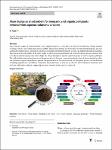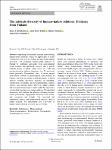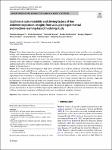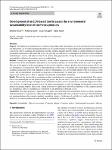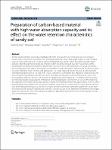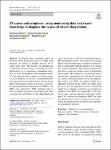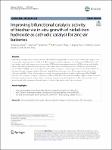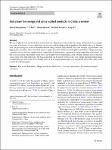Search
Author
- Osman, Ahmed I. (5)
- Chen, Zhonghao (2)
- Ricohermoso III, Emmanuel (2)
- Wang, Yongbin (2)
- next >
Subject
- LCA (6)
- ICP-MS (3)
- Artificial intelligence (2)
- CDW (2)
- next >
Date issued
Has File(s)
- true (220)
Search Results
The Solar Physics Group at the INAF-Turin Astrophysical Observatory (OATo) is actually involved in different Space Weather (SW) projects and missions. In particular, this Group is currently providing for the ESA SWESNET portal two new data analysis tools aimed at (1) the automated identification of magnetic flux ropes from the in situ data (CME magnetic effectiveness tool) and (2) the automated identification and arrival prediction of CMEs from remote sensing and in situ data (CME propagation and forecast tool). The Group is also developing numerical tools for future applications of interest for SW under the project SWELTO-Space WEather Laboratory in Turin Observatory. Moreover, the Group is participating in two SW missions, and in particular in Helianthus (research and development ... |
One of the first stages of water treatment is the coagulation process, a side effect of which is the formation of huge amounts of sludge, which is most often deposited in landfills. The residues formed as a by-product in water treatment plants are characterized by high porosity, irregularity and loose structure with limited strength, so they can exhibit adsorption properties. This article reviews the ability of Al-based sludge to adsorb inorganic pollutants and textile dyes from aqueous solutions. Due to its physicochemical properties, alum sludge has a high adsorption capacity against inorganic as well as organic pollutants. The collected literature review focuses on the presentation of the most common directions of use of these materials as effective adsorbents against the polluta... |
Supporting sustainability requires understanding human–nature relations, which we approached as social constructions that can be studied through nature-related discourses. We examined human–nature relations in Finland by combining approaches from environmental social sciences and arts-based research into a mixed-methods design. A public online survey (n = 726) and post-performance audience interviews (n = 71) portrayed nature positively. Respondents’ ideas of nature ranged from natural scientific to philosophical; from dualistic to holistic; and from ecocentric to anthropocentric. A factor analysis revealed discourses focusing on wellbeing, conservation, ecoanxiety, pro-environmentalism, outdoor activity, and enjoying nature. Interviews added spiritual and over-generational aspects ... |
Fine sediment deposition is an important component of the catchment sediment budget and affects river morphology, biology, and contaminant transfer. However, the driving factors of fine sediment deposition remain poorly understood at the catchment scale, limiting our ability to model this process. |
The objective of increasing productivity while optimizing operational and organizational processes has focused Industry 4.0 (I4.0) on technological development without considering the impact of technology on people and the impact of mass production on the environment. These impacts have led to growing concerns about climate change and complex global risks. A new vision of the industry, called Industry 5.0 (I5.0), has emerged within the scientific community. This human-centred industry appears to be a bold turn from individual technologies to a systematic approach that enables industry to achieve societal and environmental goals beyond economic growth. Under this approach, the question is no longer whether asset management should change, but what that transformation should look like.... |
The depletion of natural resources and the downgrading of the environment, driven by globalization and consumerism phenomena, are worldwide pushing the interest in sustainable manufacturing paradigm and environment preservation. It is moreover clear to academia and practitioners that the cosmetics industry needs to update its current operations to face new sustainable requirements and norms due to its ever-growing size and massive consumption of natural resources. Different methodologies, metrics, and indicators have been and are being proposed for solving the complex issues of environmental sustainability evaluation of cosmetics processes and products. |
Biochar has the potential to provide a multitude of benefits when used in soil remediation and increasing soil organic matter enrichment. Nevertheless, the intricated, hydrophobic pores and groups weaken its water-holding capacity in dry, sandy soils in arid lands. In order to combat this issue, starch-carbon-based material (SB), sodium alginate-carbon-based material (SAB), and chitosan-carbon-based material (CB) have been successfully synthesized through the graft-polymerization of biochar (BC). A series of soil column simulations were used to scrutinize the microstructure of the carbon-based material and explore its water absorption properties and its effects on sandy soil water infiltration, water retention, and aggregation. |
Ecological status assessment under the European Water Framework Directive (WFD) often integrates the impact of multiple stressors into a single index value. This hampers the identification of individual stressors being responsible for status deterioration. As a consequence, management measures are often disentangled from assessment results. To close this gap and to support river basin managers in the diagnosis of stressors, we linked numerous macroinvertebrate assessment metrics and one diatom index with potential causes of ecological deterioration through Bayesian belief networks (BBNs). |
Expanding the application scenarios of wood-derived biochar guided by the conversion of traditional energy to new energy shows great promise as a field. As thrilling energy conversion apparatus, zinc-air batteries (ZABs) require cathode catalysts with high oxygen reduction reaction (ORR) and oxygen evolution reaction (OER) activities and stability. Herein, two-dimensional nickel-iron hydroxide nanosheets were creatively assembled in N-doped wood-derived biochar (NiFe-LDH@NC) by an in-situ growth method. The categorized porous organization in wood-derived biochar facilitates the rapid seepage of electrolytes and rapid diffusion of reaction gases. The unique interfacial structure of biochar and NiFe-LDH accelerates electron transfer during oxygen electrocatalysis, and endows NiFe-LDH@... |
The rise of global waste and the decline of fossil fuels are calling for recycling waste into energy and materials. For example, rice straw, a by-product of rice cultivation, can be converted into biogas and by-products with added value, e.g., biofertilizer, yet processing rice straw is limited by the low energy content, high ash and silica, low nitrogen, high moisture, and high-quality variability. Here, we review the recycling of rice straw with focus on the global and Chinese energy situations, conversion of rice straw into energy and gas, biogas digestate management, cogeneration, biogas upgrading, bioeconomy, and life cycle assessment. The quality of rice straw can be improved by pretreatments, such as baling, ensiling, and co-digestion of rice straw with other feedstocks. The ... |


